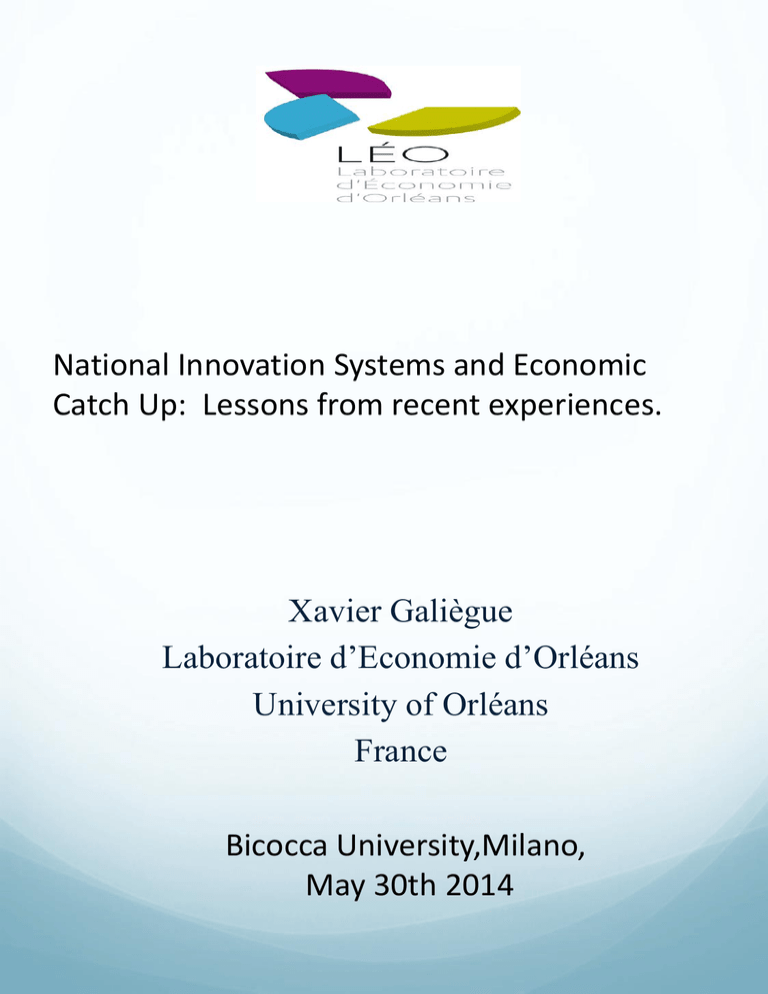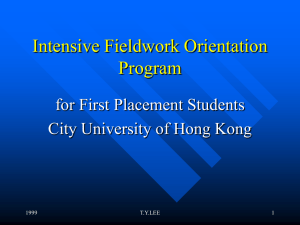Globelics 2010 8th International Conference Making Innovation
advertisement

National Innovation Systems and Economic Catch Up: Lessons from recent experiences. Xavier Galiègue Laboratoire d’Economie d’Orléans University of Orléans France Bicocca University,Milano, May 30th 2014 I Introduction • This paper will discuss issues linked to two different catch up experiences, in the European Union on one hand, and in South East Easia on the other. • Both experiences has been mainly grounded on the adoption and adaptation of prevailing techniques used in these economies. • But they showed different characteristics that should be worthwhile in implementing an industrial policy for catch up countries. • While latecomers in the European Union increased they Innovation Performance with low investment in R&D and more generally in Knowledge industries…. • ….Emerging Asians countries implemented industrial policies that allows them to upgrade their competitivity from low to middle, then upper middle and even high income countries in a relatively short period. • This industrial policy has promoted short cycle technologies that allow them to improve dramatically their international specialization in a short time. •. The adoption of these technologies is crucially linked to the accessibility of these countries to a foreign knowledge base, and of their ability to appropriate it. • On the contrary, other developing countries, after beginning their catch up process in joining the group of the middle income countries group, failed to continue this process and know a stagnation of their GDP growth, falling down into the « middle income trap » (Lee, 2013). • A first question to be addressed is linked to the ability for Central and Eastern Europe countries to avoid this middle income trap. • A second Question is linked to the ability for these countries to promote « Innovation users » The dynamics of Innovation and Technological catch up: some results from the European Experience. • UE 27 experiences large disparities in the members Innovation performance, and a fast convergence process • At first, it is important to emphasize that the Lisboa Strategy which aim to reach a 3% ratio R&D to GDP in 2010 was rather unrealistic, as its evolution over the past years proved: • • But this bad performance can be explained by large disparities in the innovation performance of member States, namely: • Central and Eastern Europa countries exhibits low RD level, lower than 1%, which exerts a negative effect on the aggregated data… • .. While the most advanced European countries knows a rise in their RD spending, far higher than the 3% ratio, as Van Pottelsberghe (2008) proved in comparing the EU members States and the US federal States Figure 1 R&D intensity of US federated states (2004) and EU Members states (2006) Figure 1 RD intensity of US Federal States (2004) and EU Members States (2006) The large disparities between European countries innovation performance are confirmed by the four CIS studies over the last ten years, and the European Innovation Scoreboard (EIS,2010, now Innnovation Union Survey, IUS). • • • • The IUS creates four categories of countries: the innovation leaders, (square,green), the immediate followers (triangle, light green), the moderate innovators (light yellow, diamondshaped) • the modest innovators (orange, circle). the EU27. The growth leaders here are Malta and Portugal. Most of the Modest innovators have grown at a faster pace than the EU27, only Lithuania has experienced a below average growth. Bulgaria and Romania are the growth leaders of the Modest innovators. FIGURE 4: CONVERGENCE IN INNOVATION PERFORMANCE 78@: 7 78@77 78?: 7 -& *+ Innovation performance 78?77 *& /, 78>: 7 1+ 78>77 4$ %& 3! !1 78: : 7 ,& /. 78: 77 ( 0 -, && 78=: 7 5$ ,$ 78=77 &- ( ) ' . 78<: 7 # $ 21 5! 78<77 78; : 7 -+ %' !" 78; 77 789: 7 A987B . 6 !$ 787B 987B ; 87B <87B =87B : 87B >87B ?87B @87B C87B Average annual growth in innovation performance Colour coding matches the groups of countries identified in Section 3.1. Average annual growth rates as calculated over a five-year period. The dotted lines show EU27 performance and growth. The average growth rates for the four country groups (Table 2) show that there is between group convergence with the Innovation followers growing at a faster rate than the Innovation leaders and the Moderate innovators growing faster than the Innovation 4 The methodology for calculating growth rates is briefly described in Section 7.2 and in more detail in the IUS 2010 Methodology report. 5 The change in the growth trend of innovation performance for Lithuania with respect to the value reported in 2009 is due to a combination of factors, including the drop of indicators on Private credit and Broadband penetration, the redefinition of indicators on Tertiary education and Community designs, the redefinition of the indicator on TBP flows into the indicator “License and patent revenues from abroad” and data updates on indicators such as Innovative SMEs collaborating with others and Sales of new to market and new to firm innovations. 10 Second, studies using the CIS Innovation Survey tried to measure the efficency of the different national innovation systems (Harfi and Mathieu, 2009). They rank countries acording to their performance in imitation or innovation, and they checked that the performance ranking of countries doesn’t fit their level of R&D investment. For example, Romania which invests less than 0,5% of its GDP in R&D is 5ththin Innovation and 7thh in imitation (over 17 countries) in technical efficiency term, as Poland and Estonia whose results are far better than their R&D investment let us guess. Another recent research confirms these results, (Veugelers, 2010), who tried to test the ability of over 24 countries from Central and Eastern Europe, the Caucasus and Central Asia (CEECCA) countries, to develop a knowledge based growth path.. These Countries can be clustered according to their ability to “buy”, or to “make” new technologies… …Some of the modest innovators belongs rather to the first rather to the second category, most of the newcomers in The European Union belongs to the category of Innovation active countries -Studies carried out by Kuen Lee (Lee , 2013) leads to a more pessimistic conclusion: it shows that Middle income countries generally present low ratios of R&D, and that the relationship with the GDP per head is flat over a long variation range. That means the R&D Productivity know large disparities between countries, and moreover that these countries haven’t any ability to rise these spending. Lee sees in this fact a main characteristics of the « Middle Income Trap »,that will be detailed later Some open questions: what kind of industrial Specialization? • Industrial Specialization and the “Middle Income Trap” • Most industrialization policies has followed a linear process, specializing in a first step in low skilled labor industries, then upgrading this specialization towards more sophisticated products and process. • This process enables these countries to leave the category of low income countries first to the middle income category, then to upper middle and even high income countries. Lee (2013) questions this linear process from two points of view • The first is that last experience from the Asian countries proved that alongside the traditional “path following catch up process”, some countries has proved their ability to skip one or more steps of this process, in a “leapfrogging” strategy. • The second is that the linear process doesn’t drive a country following it to its last stage. Some countries could be blocked in a “middle income trap”: • while they proved their ability to leave the lower income category to the middle income category…. • they could be unable to upgrade their performance and reach the highest category. Lee (2014, ibid) gives the example of Argentina and Brazil, on one side, and Korea and Taiwan, on the other side: after following the same growth path during in the 70’s and early 80’s, their GDP by head trajectories diverges dramatically during the 80 and 90’s. Figure 5 GDP per capita, 1960-2005 Figure 6 GDP per capita, 1960-2005 According to Lee, this divergence is due at first to a change in the industrialization strategy. He creates a typology in 3 categories, “Path Following” (A), “Path Skipping”(B) and “Path Creating” (C) catch up strategy The first pattern seems to be the most natural one, it is the linear process, while the second and third has been followed by South Korea and Taiwan • What are the capabilities necessary to avoid the « middle income trap »? • First, such capabilities need for the country to have an access to a large knowledge base. Park and Lee (2006) defined the accessibility to this base by measuring the share of the citations by a non-G7 country (typically, a middle-income country) held patents to the G7-held patents out of the total citation in a class. • But access to a knowledge base is a necessary, not sufficient condition to a leapfrogging strategy. It needs also a localization and a concentration of knowledge creation in the country, as they are measured by the Jaffe et al (1993) patent index. . • In this field the Korea and Taiwan performances are impressive, while on the contrary Brazil and Argentina exhibit a sharp decrease in this index of localization of knowledge creation and diffusion. Figure 6 Localization of knowledge creation and diffusion, 1975-1995 Source: Lee, 2013 This divergent evolution is due to the fact that specialization of the latter in long cycle technologies made them increasingly dependant from foreign technologies – mainly, technologies coming from Highincome countries. The key success factor in this strategy is linked to choice of the industrial sectors to be promoted • Moving investment and industrial development to short cycle technologies is a crucial point. • As rapid renewal of these technologies enables middle income countries to create their own knowledge base, and to localize knowledge creation on their territory. • It was clearly the Taiwan and Korea choice, which oriented their technology choice towards shorter life cycle technologies. Figure 7 Cycle Time of Technologies in US Patents by China, and Korea/ Taiwan How to promote Innovation Users? • According to the pioneering approach of E. Von Hippel (2005), innovation process concerns, not only its producers, but more and more its users, who are a major source of innovation product and process (Von Hippel, 1998). • Hippel (2005) argues that information and communication techniques (ITC) will help to democratize innovation, through the development of Innovation users, especially in developing and emerging economies. • Is that really true? New Innovation pattern appears in the more advanced countries, with an important population of high skilled « lead users ». • Most of the recent works on Innovation users have been done in these countries, mainly in Canada (Gault et Von Hippel, (2009)), Nederland (de Jong and Von Hippel (2008), de Jong and Von Hippel (2009)) and in Europe (Flowers, Sinozic, Patel, (2009). • This last study, , using the 2009 European Innovation Scoreboard is the most extensive ever. It draws a distinction between three kinds of Innovation users categories, named: “Process Innovation User”, “Product Innovation User”, and “Involver Innovation” • The third category is the most interesting, it appears when a firm decides to associate its product users to the evolution of their product. • According to this study: • User innovation is more developed in large firms (more than 250 and 500 employees) than in small and medium sized firms, with a slightly prevalence in middle and high technology industries. • All industries are evenly concerned by this kind of Innovation. • Between countries, User innovation is more widespread in the innovation leaders countries , even if the observed disparities between countries categories are rather small. • On the average, in the European Union, 30,3% of firms are User process innovators, 27% innovation product innovators, and 53,1% involver innovators, a higher proportion than observed on former studies, where it reach the average of 20% of the Innovative firms. In a few words, firms and countries that have the highest capability to produce innovation are the most able to use it. It should not be surprising: it means that innovation production and use are more complementary than substitute. Flowers and alii go so far as calling the innovation users as “super innovators”, which have to be promoted by innovation policies (Flowers and alii, op. cit., 2009), in advanced countries to reach the technological frontier, as in developing countries. Lets point out that the first Free Open Source Software(FOSS) appeared in the community of computer “ geeks ” coming from University or computing company of the more advanced countries. Even the Ubuntu software, although born in Africa, owes his success to its adoption in advanced countries. Conclusion • If a catch up process is engaged in the Eastern and Southern Europe Countries, it is basically because these countries have been able to develop their own technological and social capabilities, which allow them to adopt external technology at a low cost. • If these countries want to go further in the process of technological appropriation, they need to develop Short cycle technologies. • But they should also promote innovation users, who will have the ability to find use of products adapted to the needs of their enterprises and population, as product, process and involver innovation. • Thank you for your attention











